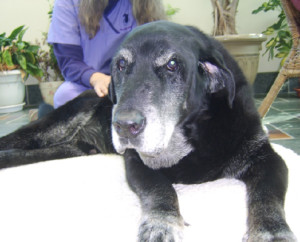What you might not know about it.
I always say that I learn a lot from my dogs, but this is the one thing, I wish I never had to learn the hard way, because it just broke my heart.
yme disease sounds scary, but you know I thought that I protected my dogs the best ways possible. They had their Lyme vaccine every year, and then their heartworm test on a yearly basis as well as Frontline every month not to name it!
Three and half years ago, it was Labor Day weekend, and on Sunday, George, my 3 and half years old black lab was fine and goofing around as usual. The next morning when I woke up, his legs were so swollen, he could not walk. Sometimes you wonder how you do things that you thought you would not be able to do. I carried my 80lbs dog to my truck and we flew to the emergency.
Funny how I did not have a bad feeling about it. I thought he was going to be okay. My beautiful and sweet boy. George had always been glued to me. I could not sit anywhere without having him right away on my lap. I don’t think he ever knew he was a dog.
As soon as they drew some blood, the diagnosis came back: kidney failure due to most likely Lyme Nephritis. He tested highly positive for Lyme. I still thought that he was going to be okay. The vet knew but did not know how to tell me. Lyme Nephritis is a bitch. It’s a disease slowly destroying the kidneys without any precursor signs. It’s a little bit like the body is fighting the kidneys like it doesn’t know they are good guys. It started with a tick infected with Lyme, and for whatever reason instead of fighting Lyme, George’s body decided to go after his kidneys. He was at this emergency on Monday, then on Tuesday I took him to a Veterinary Referral Center in Leesburg.
During the ride, George decided that he did not want to be stuck in the back of the truck and jumped to come to his favorite spot: the passenger front seat. I thought it was a good sign, right? He still had his catheter and everything. When we arrived, he was not that great anymore and they had to get a stretcher. They were amazing over there. It was the Life Center in Leesburg. I went there at the recommendation of the emergency vet. If the internist I saw could do something, it was her. After talking to the internist, Dr. Miller, I left and was supposed to come back early afternoon.
When I came back that afternoon with my youngest daughter, the news were dire. His organs were shutting down, and it was a matter of hours. I could not let him die by himself, so we decided to put him to sleep. I still see him coming with all his IVs and his darn tail still wagging.
In a few minutes, my sweet boy was gone, and I was left empty handed with his collar. Three and half years later, I am still grieving my boy. He was only 3 and half years old, only 3 and half years old. How fair is that?
At that time, my vet had just retired and I had just changed to a new one. I still had George’s Mom, Lola, and his siblings: two sisters, Sophie (Sophie was attached by the hip with George, and it took her some time to recover from her loss. If anyone tells me that dogs don’t grieve, they know nothing about dogs!), Zoe, and then his two brothers, Max and Jackson as well as Maia’s, Lola’s girlfriend. Are you confused enough with my crew now?
I was grieving my boy, but I was SO angry, and I needed to understand. The first thing my new vet told me was “you must have mice where you live?”
“Excuse me?”
“Mice are the ones which infect ticks with Lyme disease?”
I always thought it was the deer. So, it was breaking news for me: deer carry ticks around like birds, squirrels, foxes, and all wild critters. They might carry more ticks than other animals, but THEY DO NOT GIVE LYME TO TICKS. For a tick to be infected with Lyme, at one stage of its life, it has to have been in contact with one of those “deer mice” or white footed mice. Did you know about it? I sure did not? When I started doing research online, then I did discover that it was true. My garage was infested with mice, my truck was infested with mice, and I did not know the threat it was for my dogs or me as a matter of fact.
I called DNR to ask them if they could mention on their website the white footed mice and the Lyme transmission. I never succeeded. I was fighting ignorance, and good luck fighting it! I went nowhere.
In one sentence: if WE COULD ERADICATE THE DEER MICE, LYME DISEASE WOULD DISAPPEAR LITTLE BY LITTLE.
THE FACTS:
- LYME VACCINE: there is no real way to say that this vaccine is working. If you think about it, if the vaccine was effective for the dogs, don’t you think we would have one for us, humans? Breaking news: we don’t. It covers some strains of the Lyme disease but just a few. I stopped giving that vaccine to my crew after doing a lot of research online.
- HEARTWORM TEST: even when it’s positive, many vets don’t do anything about it if the dog is not sick because it just meant that at one point, the dog had to fight the disease but if there is no sign, some vets won’t do a thing because so many dogs test positive.
- FRONTLINE: If you read – the little notice on Frontline, it says that it can take up to 24 hours to be effective. Breaking news: a tick can infect a dog within 12 hours. There are now better products that Frontline. Not sure why so many vets still recommend the darn thing. It has been around forever. It’s comfortable I guess.
WHAT I DO:
- LYME VACCINE: out of the picture. My dogs don’t get that shot anymore.
- HEARTWORM TEST: I still do it but I do not rely on it. Instead what I do is a urine test every six months. If there is any protein in the urine, then Houston we have a problem.
- TICKS AND FLEAS REPELLENT: I now use K9 Advantix II which kills ticks within an hour or less. I use it EVERY MONTH no matter what the temperature is, because breaking news again: Ticks did not read the notice saying they have to die when it’s below freezing. You can find ticks these days any month of the year.
- They have those new medications which are not as messy since your dog can swallow a pill instead of you having to apply it below his neck. They are not as effective, and furthermore, but it might just be me but that stuff is a pesticide. Do I want my dogs to swallow a pesticide? Nope!
Last, unfortunately, Lyme Nephritis attacks mostly young dogs, and the two favorite breeds are Labrador Retrievers and Golden Retrievers. No clue why. It just happens. So, if you do have a young retriever, just be careful, be aware that there might not be signs, and when they show, it could be too late. I am not saying that what I do is 100% effective, BUT the urine test every six months if you live in a tick infested area, is really the best thing you can do to be sure the kidneys are in good shape, and with a great tick repellent, that’s probably the best you can do to protect your dog. And last, if you have mice where you live, GET RID OF THEM, and I mean it. Not with ultra sounds but with good all traps. I cannot see a mouse now without thinking of my boy.
 As you know, I am not a vet, but I learned the hard way that vets don’t really share their knowledge (they don’t have time!) and you have to learn by yourself a lot of stuff. I just wish I did not have to do it the hard way by losing my 3 and half year old rambunctious boy, my George. If that blog can spare ONE life, I would be happy.
As you know, I am not a vet, but I learned the hard way that vets don’t really share their knowledge (they don’t have time!) and you have to learn by yourself a lot of stuff. I just wish I did not have to do it the hard way by losing my 3 and half year old rambunctious boy, my George. If that blog can spare ONE life, I would be happy.

 A few years ago, I was telling my ex vet (one of the reasons, he became my ex vet) that I was taking Zeus to Reiki every week, and he asked me: “Reiki Who?” I can’t get over that one!
A few years ago, I was telling my ex vet (one of the reasons, he became my ex vet) that I was taking Zeus to Reiki every week, and he asked me: “Reiki Who?” I can’t get over that one! Exactly one year ago, at 4:15 pm, we put you to sleep. Labor Day weekend will always be associated with you, no matter what. Here goes one less holiday to celebrate! I hope you are in peace, free of pain, my beautiful boy.
Exactly one year ago, at 4:15 pm, we put you to sleep. Labor Day weekend will always be associated with you, no matter what. Here goes one less holiday to celebrate! I hope you are in peace, free of pain, my beautiful boy. Yes, you heard me right, and believe me until four years ago, I had no idea that was such a common thing.
Yes, you heard me right, and believe me until four years ago, I had no idea that was such a common thing.


